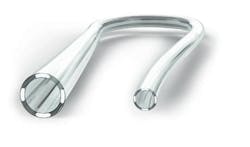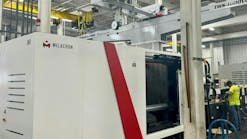In February, three equipment suppliers worked together to demonstrate for the first time the coextrusion of a unique tiny catheter with embedded stripes made from barium sulfate that can be seen on an X-ray.The suppliers that demonstrated the tube extrusion line at Plastec West in Anaheim were Davis-Standard, Conair Group and Zumbach Electronics.
The coextruded tube made from clear Teflon FEP (fluorinated ethylene propylene) is just 1.4mm thick. It is a difficult catheter to manufacture because of the high processing temperature of the FEP compared to the barium sulfate (BaSO4), which burns easily.
"That's part of the secret" of the project, said Jason Baird, senior process engineer at Davis-Standard. "A lot of development went into this. It was a balance of not burning the BaSO4 while avoiding melt fracture typically seen with FEP."
The technology has other potential uses, such as making the embedded stripes from antibiotics for catheters that must be left in the body for long periods of time. Prolonged use of a catheter carries a high risk of infection and sepsis.
The body of the FEP catheter was processed on a 0.75-inch Davis-Standard Medical Extruder Direct Drive (MEDD). A second identical MEDD embedded four equally spaced, white Teflon FEP stripes around the outside of the tube. Extruders in the MEDD line use direct-drive technology that has a replaceable feed section liner, interchangeable barrel assembly and Davis-Standard's EPIC III control system.
Guill Tool & Engineering provided a crosshead coextrusion die to combine the two resin streams that form the main body of the tube and the four stripes.
Once the tube came out of the die, it went through a Conair MedVac vacuum-sizing/cooling tank that created pressure inside the tube to stabilize dimensions and prevent cooling water from seeping out of the tank as the tube exited. If water escapes, it could mar the surface finish of the tube, said Bob Bessemer, sales manager for medical downstream extrusion equipment at Conair.
A Zumbach ultrasonic wall gauge inside the tank monitored the tube's 0.4mm wall thickness. A Zumbach three-axis outside-diameter laser gage downstream from the tank provided closed-loop dimensional control and displayed the tube on a monitor for concentricity adjustments.
Data from the gauges controls puller speed and vacuum to maintain tube dimensions.
The tube was next checked by an SI 3100SD surface detection vision system from Taymer International Inc. The vision system looked for gels and other surface imperfections. Tubes with imperfections were automatically separated.
A Conair MedLine puller/cutter cut the tube to specified lengths that were then removed on a Conair medical takeaway belt conveyor. Cut pieces that do not meet quality standards for inside or outside dimensions, or data from the in-line vision machine, can be removed from the conveyor with compressed air.
The extruders were equipped with Conair's MicroWheel MW1-0.2 dryers with a 0.2 cubic foot hopper. Conair temperature-control units (TCUs) supplied water to the extruder feed throat that matched the ambient temperature to prevent condensation; one supplied warm water to the sizing/cooling tank to control heat removal.
A portable Conair EP1A-03 air-cooled chiller and a TB-45 TrueBlend gravimetric blender completed the line.Davis-Standard is the integrator of the line.
Ron Shinn, editor[email protected]
Contacts:
Conair Group,Cranberry Township, Pa., 724-584-5500,www.conairgroup.com
Davis-Standard LLC,Pawcatuck, Conn., 860-599-1010,www.davis-standard.com
Guill Tool & Engineering Co. Inc.,West Warwick, R.I. 401-828-7600,www.guill.com
Taymer International Inc.,Markham, Ontario, 905-479-2614,www.taymer.com
Zumbach Electronics Corp.,Mount Kisco, N.Y., 914-241-7080,www.zumbach.com
Ron Shinn | Editor
Editor Ron Shinn is a co-founder of Plastics Machinery & Manufacturing and has been covering the plastics industry for more than 35 years. He leads the editorial team, directs coverage and sets the editorial calendar. He also writes features, including the Talking Points column and On the Factory Floor, and covers recycling and sustainability for PMM and Plastics Recycling.






